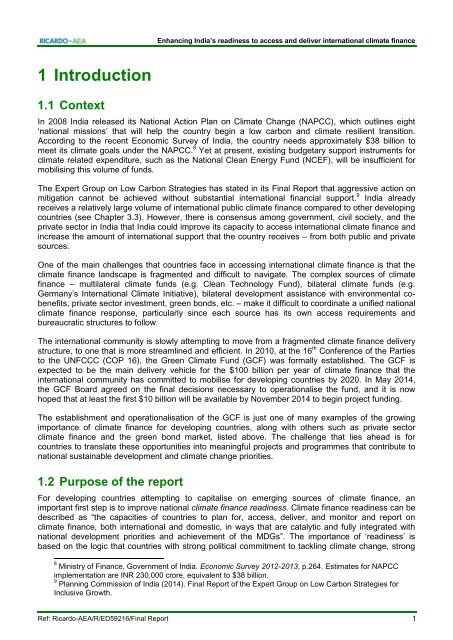Enhancing India’s Readiness to Climate Finance
India has taken several steps to improve its national response to climate change. India’s climate finance requirements, however, are very high, and will need to be met through a combination of public, private and international climate finance. See more at: http://shaktifoundation.in/
India has taken several steps to improve its national response to climate change. India’s climate finance requirements, however, are very high, and will need to be met through a combination of public, private and international climate finance. See more at: http://shaktifoundation.in/
- No tags were found...
Create successful ePaper yourself
Turn your PDF publications into a flip-book with our unique Google optimized e-Paper software.
<strong>Enhancing</strong> <strong>India’s</strong> readiness <strong>to</strong> access and deliver international climate finance<br />
1 Introduction<br />
1.1 Context<br />
In 2008 India released its National Action Plan on <strong>Climate</strong> Change (NAPCC), which outlines eight<br />
‘national missions’ that will help the country begin a low carbon and climate resilient transition.<br />
According <strong>to</strong> the recent Economic Survey of India, the country needs approximately $38 billion <strong>to</strong><br />
meet its climate goals under the NAPCC. 8 Yet at present, existing budgetary support instruments for<br />
climate related expenditure, such as the National Clean Energy Fund (NCEF), will be insufficient for<br />
mobilising this volume of funds.<br />
The Expert Group on Low Carbon Strategies has stated in its Final Report that aggressive action on<br />
mitigation cannot be achieved without substantial international financial support. 9 India already<br />
receives a relatively large volume of international public climate finance compared <strong>to</strong> other developing<br />
countries (see Chapter 3.3). However, there is consensus among government, civil society, and the<br />
private sec<strong>to</strong>r in India that India could improve its capacity <strong>to</strong> access international climate finance and<br />
increase the amount of international support that the country receives – from both public and private<br />
sources.<br />
One of the main challenges that countries face in accessing international climate finance is that the<br />
climate finance landscape is fragmented and difficult <strong>to</strong> navigate. The complex sources of climate<br />
finance – multilateral climate funds (e.g. Clean Technology Fund), bilateral climate funds (e.g.<br />
Germany’s International <strong>Climate</strong> Initiative), bilateral development assistance with environmental cobenefits,<br />
private sec<strong>to</strong>r investment, green bonds, etc. – make it difficult <strong>to</strong> coordinate a unified national<br />
climate finance response, particularly since each source has its own access requirements and<br />
bureaucratic structures <strong>to</strong> follow.<br />
The international community is slowly attempting <strong>to</strong> move from a fragmented climate finance delivery<br />
structure, <strong>to</strong> one that is more streamlined and efficient. In 2010, at the 16 th Conference of the Parties<br />
<strong>to</strong> the UNFCCC (COP 16), the Green <strong>Climate</strong> Fund (GCF) was formally established. The GCF is<br />
expected <strong>to</strong> be the main delivery vehicle for the $100 billion per year of climate finance that the<br />
international community has committed <strong>to</strong> mobilise for developing countries by 2020. In May 2014,<br />
the GCF Board agreed on the final decisions necessary <strong>to</strong> operationalise the fund, and it is now<br />
hoped that at least the first $10 billion will be available by November 2014 <strong>to</strong> begin project funding.<br />
The establishment and operationalisation of the GCF is just one of many examples of the growing<br />
importance of climate finance for developing countries, along with others such as private sec<strong>to</strong>r<br />
climate finance and the green bond market, listed above. The challenge that lies ahead is for<br />
countries <strong>to</strong> translate these opportunities in<strong>to</strong> meaningful projects and programmes that contribute <strong>to</strong><br />
national sustainable development and climate change priorities.<br />
1.2 Purpose of the report<br />
For developing countries attempting <strong>to</strong> capitalise on emerging sources of climate finance, an<br />
important first step is <strong>to</strong> improve national climate finance readiness. <strong>Climate</strong> finance readiness can be<br />
described as “the capacities of countries <strong>to</strong> plan for, access, deliver, and moni<strong>to</strong>r and report on<br />
climate finance, both international and domestic, in ways that are catalytic and fully integrated with<br />
national development priorities and achievement of the MDGs”. The importance of ‘readiness’ is<br />
based on the logic that countries with strong political commitment <strong>to</strong> tackling climate change, strong<br />
8 Ministry of <strong>Finance</strong>, Government of India. Economic Survey 2012-2013, p.264. Estimates for NAPCC<br />
implementation are INR 230,000 crore, equivalent <strong>to</strong> $38 billion.<br />
9 Planning Commission of India (2014). Final Report of the Expert Group on Low Carbon Strategies for<br />
Inclusive Growth.<br />
Ref: Ricardo-AEA/R/ED59216/Final Report<br />
1

















